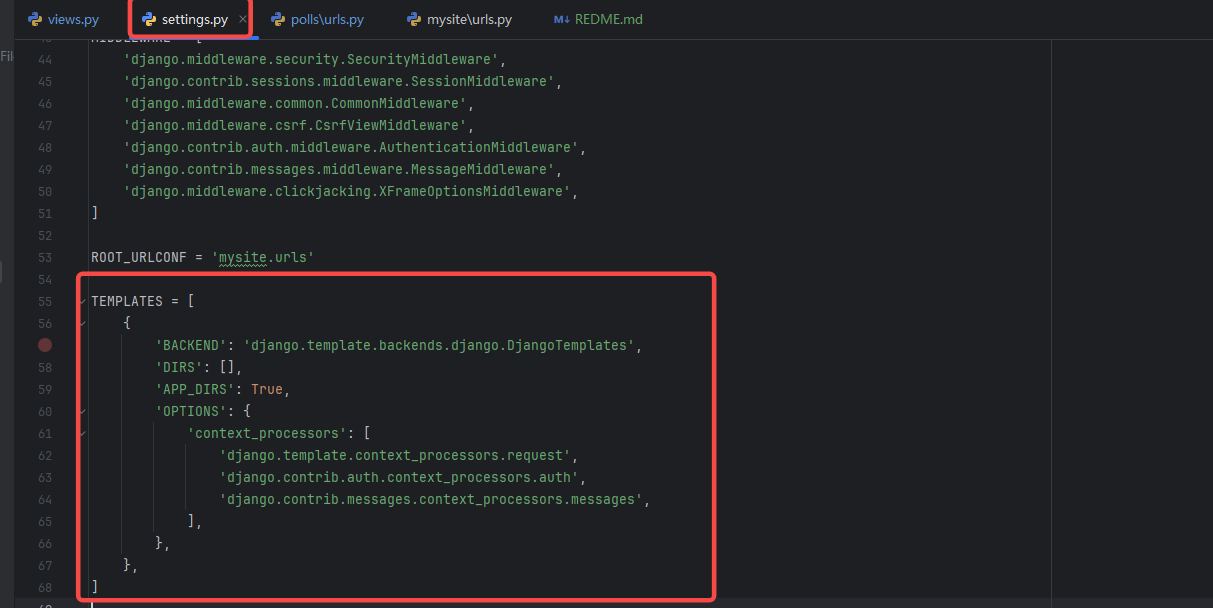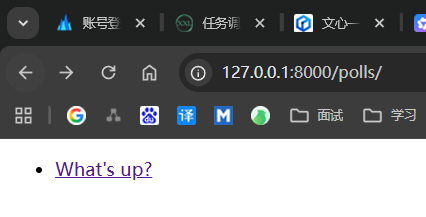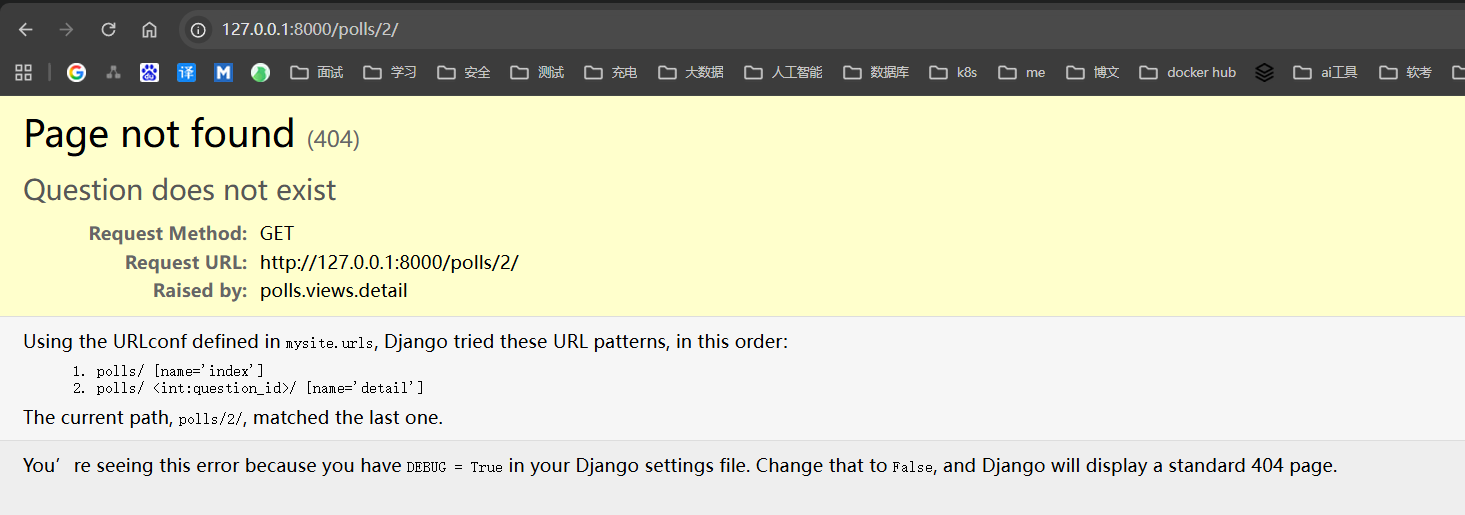Django入门-3.公共视图
公共视图
视图 是具有 一类具有相同功能和模板的网页的集合,网页和其他内容都是从视图派生而来。每个视图是一个python函数。
一般情况下URL形式: /newsarchive/<year>/<month>/
为了将 URL 和视图关联起来,Django 使用了 ‘URLconfs’ 来配置。URLconf 将 URL 模式映射到视图。
其实就是类似于web项目里面的Controller里面的一个方法【一个GetMapping或者RequestMapping类似】
添加视图
在 pulls/views.py 中添加方法
from django.shortcuts import render
from django.http import HttpResponsedef index(request):return HttpResponse("Hello, world. You're at the polls index.")def detail(request, question_id):return HttpResponse("You're looking at question %s." % question_id)def results(request, question_id):response = "You're looking at the results of question %s."return HttpResponse(response % question_id)def vote(request, question_id):return HttpResponse("You're voting on question %s." % question_id)
在 pulls/urls.py 中添加路径映射, 类似于 java web 中的
urlpatterns = [path("", views.index, name="index"),path("<int:question_id>/", views.detail, name="detail"),path("<int:question_id>/results/", views.results, name="results"),path("<int:question_id>/vote/", views.vote, name="vote"),]
全局的 mysite/urls.py 已经 引入了 pulls/urls.py 就不需要变更了
在浏览器输入
/polls/34 会根据path进行匹配到detail方法中
每个视图都必须要做的是返回一个HttpResponse对象或者抛出异常比如 Http404
举例从 index() 方法改下
from polls.models import Questiondef index(request):latest_question_list = Question.objects.order_by('-pub_date')[:5] # 查询数据库 根据 pub_date 逆序 取5条数据output = ", ".join([q.question_text for q in latest_question_list])return HttpResponse(output)
编辑页面
在polls 目录里创建一个 templates 目录。
项目的 TEMPLATES 配置项描述了 Django 如何载入和渲染模板。默认的设置文件设置了 DjangoTemplates 后端,并将 APP_DIRS 设置成了 True。这一选项将会让 DjangoTemplates 在每个 INSTALLED_APPS 文件夹中寻找 “templates” 子目录。这就是为什么尽管我们没有像在第二部分中那样修改 DIRS 设置,Django 也能正确找到 polls 的模板位置的原因。

在刚刚创建的 templates 目录里,再创建一个目录 polls,然后在其中新建一个文件 index.html 。换句话说,你的模板文件的路径应该是 polls/templates/polls/index.html 。因为app_directories 模板加载器是通过上述描述的方法运行的,所以 Django 可以引用到 polls/index.html 这一模板了
polls/templates/polls/index.html文件内容
<!doctype html>
<html lang="en-US"><head><meta charset="utf-8" /><title>question list</title></head><body>{% if latest_question_list %}<ul>{% for question in latest_question_list %}<li><a href="/polls/{{ question.id }}/">{{ question.question_text }}</a></li>{% endfor %}</ul>
{% else %}<p>No polls are available.</p>
{% endif %}</body>
</html>
然后 修改 polls/views.py 里的 index 视图来使用我们创建的模板
from django.template import loaderfrom polls.models import Questiondef index(request):latest_question_list = Question.objects.order_by('-pub_date')[:5] # 查询数据库 根据 pub_date 逆序 取5条数据template = loader.get_template("polls/index.html") # 获取对应的模版context = {"latest_question_list": latest_question_list} # 参数绑定,传递上下文,字典return HttpResponse(template.render(context, request)) # 返回对象
地址栏访问 http://127.0.0.1:8000/polls/

快捷函数: render()
上面的流程配置还是有很多重复的代码,如果编写多个方法的时候
from django.shortcuts import renderfrom .models import Questiondef index(request):latest_question_list = Question.objects.order_by("-pub_date")[:5]context = {"latest_question_list": latest_question_list}return render(request, "polls/index.html", context)
抛出 错误
可以用来处理一些异常数据
def detail(request, question_id):try:question = Question.objects.get(pk=question_id)except Question.DoesNotExist:raise Http404("Question does not exist")return render(request, "polls/detail.html", {"question": question})
如果指定问题 ID 所对应的问题不存在,这个视图就会抛出一个 Http404 异常。
同时我们对应的 页面
polls/templates/polls/detail.html文件内容
<!doctype html>
<html lang="en-US"><head><meta charset="utf-8" /><title>question list</title></head><body>{{ question }}</body>
</html>


快捷函数: get_object_or_404()
尝试用 get() 函数获取一个对象,如果不存在就抛出 Http404 错误也是一个普遍的流程。Django 也提供了一个快捷函数,下面是修改后的详情 detail() 视图代码:
from django.shortcuts import get_object_or_404, renderfrom .models import Questiondef detail(request, question_id):question = get_object_or_404(Question, pk=question_id)return render(request, "polls/detail.html", {"question": question})
也有 get_list_or_404() 函数,工作原理和 get_object_or_404() 一样,除了 get() 函数被换成了 filter() 函数。如果列表为空的话会抛出 Http404 异常。
使用模版系统
polls/detail.html 模板里正式的代码
<!doctype html>
<html lang="en-US">
<head><meta charset="utf-8" /><title>question list</title>
</head>
<body>
<h1>{{ question.question_text }}</h1>
<ul>{% for choice in question.choice_set.all %}<li>{{ choice.choice_text }}</li>{% endfor %}
</ul>
</body>
</html>
模板系统统一使用点符号来访问变量的属性。在示例 {{ question.question_text }} 中,首先 Django 尝试对 question 对象使用字典查找(也就是使用 obj.get(str) 操作),如果失败了就尝试属性查找(也就是 obj.str 操作),结果是成功了。如果这一操作也失败的话,将会尝试列表查找(也就是 obj[int] 操作)。
在 {% for %} 循环中发生的函数调用:question.choice_set.all 被解释为 Python 代码 question.choice_set.all() ,将会返回一个可迭代的 Choice 对象,这一对象可以在 {% for %} 标签内部使用。
去除模板中的硬编码 URL
我们在 polls/index.html 里编写投票链接时,链接是硬编码的:
<li><a href="/polls/{{ question.id }}/">{{ question.question_text }}</a></li>
这种硬编码、强耦合的方法的问题在于,在具有大量模板的项目中更改 URL 变得具有挑战性。然而,由于你在 polls.urls 模块中的 path() 函数中定义了 name 参数,你可以通过使用 {% url %} 模板标签来消除对 url 配置中定义的特定 URL 路径的依赖:
<li><a href="{% url 'detail' question.id %}">{{ question.question_text }}</a></li>
这个标签的工作方式是在 polls.urls 模块的 URL 定义中寻具有指定名字的条目。你可以回忆一下,具有名字 ‘detail’ 的 URL 是在如下语句中定义的:
path("<int:question_id>/", views.detail, name="detail"),
如果你想改变投票详情视图的 URL,比如想改成 polls/specifics/12/ ,你不用在模板里修改任何东西(包括其它模板),只要在 polls/urls.py 里稍微修改一下就行:
path("specifics/<int:question_id>/", views.detail, name="detail"),
为 URL 名称添加命名空间
教程项目只有一个应用,polls 。在一个真实的 Django 项目中,可能会有五个,十个,二十个,甚至更多应用。Django 如何分辨重名的 URL 呢?举个例子,polls 应用有 detail 视图,可能另一个博客应用也有同名的视图。Django 如何知道 {% url %} 标签到底对应哪一个应用的 URL 呢?
答案是:在根 URLconf 中添加命名空间。在 polls/urls.py 文件中稍作修改,加上 app_name 设置命名空间:
from django.urls import pathfrom . import viewsapp_name = "polls" # 新加命名空间
urlpatterns = [path("", views.index, name="index"),path("<int:question_id>/", views.detail, name="detail"),path("<int:question_id>/results/", views.results, name="results"),path("<int:question_id>/vote/", views.vote, name="vote"),
]
现在,编辑 polls/index.html 文件,从:
<li><a href="{% url 'detail' question.id %}">{{ question.question_text }}</a></li>
修改为指向具有命名空间的详细视图:
<li><a href="{% url 'polls:detail' question.id %}">{{ question.question_text }}</a></li>
